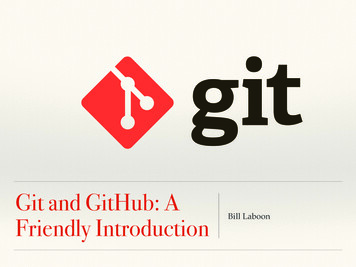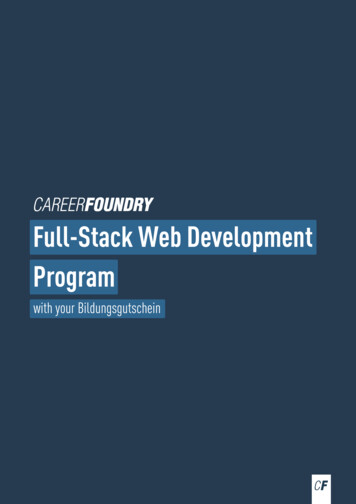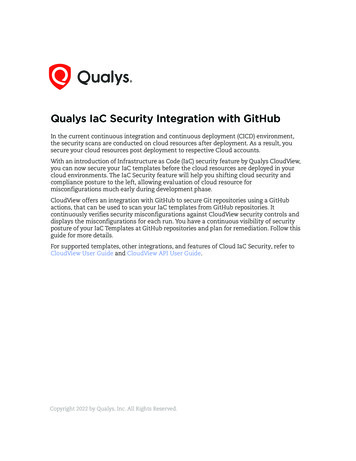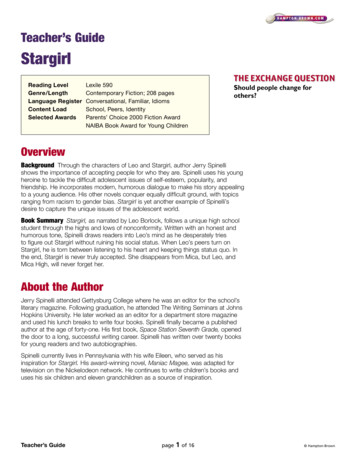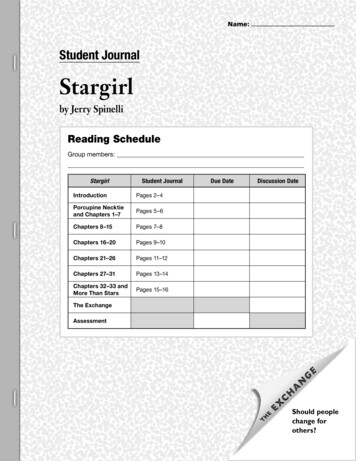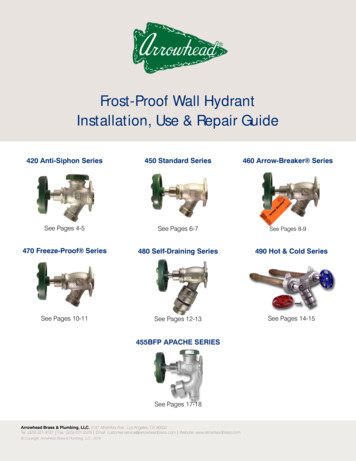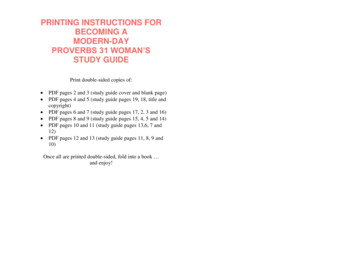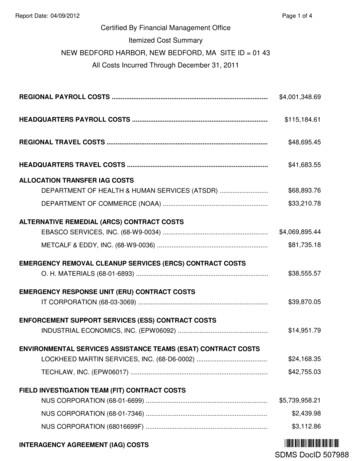
Transcription
COSTS OF PRODUCTIONInstructor: Ghislain Nono GueyeAUBURN UNIVERSITY1
Introduction People create firms because they want to make money. Whether they deal in goods (e.g. Walmart, GM, Sony, ) or in services(e.g. Barber shops, car cleaning, medical clinics ), all firms aim atmaking profit. However, making profit by creating a firm does not come free ofcharge. There are costs attached to this endeavor (e.g. cost of capital,administrative costs, various setup costs )2
What are costs? Generally speaking, a cost is what you have to give up in order toacquire something you want. In production, a cost is the necessary initial investment needed toinitiate the production process. For instance, the cost of making and selling hotdogs is the moneyinvested in bread, sausages, mayonnaise, mustard and a grill. These are prerequisites if one wants to produce and sell hotdogs forprofit.3
The two main categories of costs The production of certain goods requires very many costs. For example, opening a business in the car manufacturing industrycomes with hundreds of costs. However, whatever the cost, it falls within one of two main categoriesof costs:- Explicit costs- Implicit costs4
Explicit costs Within the category of explicit costs, there are:- Variable costsThese are costs that change with the level of production/output.They increase as output increases and they decreases as outputdecreases.- Fixed costsFixed costs do not immediately change with the level of output.They only change when the output significantly increases.5
Explicit costs: illustrated Carmen wants to open a firm to sell cookies. She buys flour, sugar, chocolate chips She also buys an oven. Now she is good to go!!!6
Explicit costs: illustrated (2) Variable costs are costs that change with the level ofproduction/output. Carmen’s variable costs are flour, sugar and chocolate chips. If she wants to increase/increase her production of cookies, she hasto buy more/less of them.7
Explicit costs: illustrated (3) Fixed costs are costs that do not easily change with the level ofproduction/output. Carmen’s fixed cost is the oven. Producing more cookies does not immediately require the purchaseof another oven. But at some higher levels of production, Carmen will need topurchase a new oven.8
Implicit costs There are many kinds of implicit costs in a firm. They can all be grouped under the concept of opportunity costs. For example, the owner of a business may run an errand for the firmusing his own car. He will not necessarily take money from the business for his labor orfor the use of his car. He would have earned money if he had run that errand for anotherbusiness. This is an implicit cost.9
Production periods There are two main production periods in the life cycle of any firm:- The short-run- The long-run These two production periods are determined by whether the firmhas fixed costs or not. Let’s illustrate 10
Production periods: the short run Reminder: Carmen’s variable costs are flour, sugar and chocolatechips. Her fixed cost is the oven. Let’s assume that Carmen can only make 50 cookies per day with oneoven. So long as the quantity demanded for her cookies is 50 or lower, sheis just fine with one oven. The entire time period within which she only needs one oven (i.e. thefixed cost) is called the short run.11
Production periods: the long run Now Carmen has become very popular on Auburn campus. The demand for her cookies has now exceeded 50 cookies per day. Therefore, she needs to buy a second oven. At this point, there is no more fixed cost. The oven has now become a variable cost. Carmen’s firm has now entered the long run. This is the productionperiod in which the previous fixed costs are not fixed anymore.12
How to calculate profit (loss)? One of the most important objectives of any firm is to make profit. Firms make profit according to this formulaTotal Profit/Loss Total Revenue – Total (Explicit) CostTotal Profit/Loss (P * Q) – (TFC TVC)Total Revenue Price * Quantity soldTotal Cost Total Fixed Costs Total Variable Costs13
Accounting profit vs Economic profit The profit computed as seen on the previous slide is called accountingprofit. The economic profit is computed by including opportunity costs tothe equation.Total Profit Total Revenue – Total CostTotal Profit (P * Q) – (TFC TVC OC)Total Revenue Price * Quantity soldTotal Cost Total Fixed Costs Total Variable Costs Opportunity Costs14
The production function In the production process, inputs are used to make outputs. The costs incurred by the firm are very closely linked to the level ofinputs used in the production process. In the example of the cookie selling firm owned by Carmen, theinputs are: sugar, flour, chocolate chips and the oven. Now, let’s assume that the firm’s sole inputs are the number of hiredworkers. The relationship between the inputs the firm uses and the output itcreates is shown by the production function. Following is a hypothetical production function:15
The production function (2)Number of workers(Variable Inputs)Total Product (TP)(Number of cookies produced per day)Marginal Product of -41055-816
The production function (3) The marginal product of labor is the additional output (i.e. the extranumber of cookies) produced when one more worker is hired in thefirm. When the firm has only 1 worker, 5 cookies are produced every day. When the firm hires a second worker, the production of cookies perday increases to 15. Therefore, the marginal product of hiring a second worker in the firmis 10.17
The production function (4) From 0 to 3 workers:- Total output rises at an increasing rate. It rises rapidly!- Marginal product is positive and is rising. From 4 to 8 workers:- Total output rises at a decreasing rate. It rises slowly!- Marginal product is positive and is declining. From 9 to 10 workers:- Total output declines.- Marginal product is negative.18
The production function (5)338108*Variable input number of workers19
The production function (6) The total output (i) increases, (ii) reaches a maximum point and then(iii) decreases. The marginal production (i) increases, (ii) decreases and (iii) furtherdecreases below zero. The total output curve is convex when the marginal product curveincreases. The total output curve is convex when the marginal product curvedecreases. The total output curve slopes downward when the marginal productcurve is below zero.20
The 3 production phases Here, we identify three (3) main production phases.(i) The first phase (0 to 3 workers) with increasing marginal product(increasing returns)(ii) The second phase (4 to 8 workers) with diminishing marginalproduct (decreasing returns)(iii) The third phase (9 to 10 workers) with negative marginal product(negative returns)21
The 3 production phases (2)(i) The production phase of increasing returnsIn this production phase, increases in variable inputs (i.e. number ofworkers) lead to an increase in the total output (i.e. number of cookiesproduced per day) Here, the total output increases rapidly.(ii) The production phase of diminishing returnsIn this production phase, increases in variable inputs (i.e. number ofworkers) lead to an increase in the total output (i.e. number of cookiesproduced per day). Here, the total output increases slowly.22
The 3 production phases (3)(iii) The production phase of negative returnsIn this production phase, increases in variable inputs (i.e. number ofworkers) lead to a decrease in the total output (i.e. number of cookiesproduced per day).23
Decision-making in the firm The production function of the firm gives us all the information we needabout how inputs and output are related. So, it is useful in the decision-making process. For instance: If the firm wants to be the most profitable, how much output should beproduced every day? Questions about the level of production such as this one are veryimportant for firms. However, another very important aspect to take into consideration is cost. Therefore, production and cost are the main factors when making decisionsin a firm.24
Short-run costs Production and cost considerations are different depending on theproduction period. Following is a hypothetical short-run cost schedule.25
TotalProductTotalVariableCost ( )Total FixedCost ( )Total Cost( )AverageVariableCost ( )AverageFixed Cost( )AverageTotal Cost( )MarginalCost ( 0408026
Formulas TC TFC TVC ATC AFC AVC ATC TC/Q AFC TFC/Q AVC TVC/Q MC ΔTVC / ΔQ ΔTC / ΔQ (because TFC does not change. It is fixed)27
What is marginal cost? Marginal cost in the additional cost incurred by the company as aresult of producing one more unit of output. In other words It is how much it costs the company to produce one more unit ofoutput.28
Short-run cost curvesEfficient scale29
Short-run cost curves (2) The TC and TVC curves have the same shape. The vertical distancebetween them is the value of the TFC. The MC, AVC and ATC curves are all U-shaped. The ATC curve lies above the AVC curve. The vertical distancebetween them in the value of the AFC. The AFC curve is L-shaped. The MC curve (in its upward sloping part) cuts the AVC and the ATCcurves at their lowest points. The lowest point on the ATC curve is called the efficient scale.30
Long-run costs In the short run, there are fixed costs. In the long run, all costs are variable. In the short run, the only decisions that are made are related to thelevel of production. In our earlier example, Carmen could decide to increase herproduction from 7 cookies to 8 cookies per day. In the short run, the change in the level of production is not verysignificant.31
Long-run costs (2) In the long-run, the decisions are made with respect to the scale ofthe firm’s activities. When Carmen buys a second oven or even rents a second spot oncampus to sell her cookies, her level of production changessignificantly. The cost structure of her company will be affected. Let’s talk about how the average total cost of the company changes inthe long run.32
The long-run average total cost curveSRATC: Short Run Average Total Cost33
The long-run average total cost curve There are three main phases in the long-run average total cost curve.- The first phase, where the average total cost falls- The second phase, where the average total cost remains constant- The last phase, where the average total cost rises The changes in the average total cost are respectively due to:- Economies of scale (or increasing returns to scale)- Constant returns to scale- Diseconomies of scale (or decreasing returns to scale)34
Economies of scale Economies of scales are factors that cause the average total cost of afirm to fall as the output scale of the firm rises. Hence it may cost a firm 1000 to produce 10 units of a good and 1500 to produce 20 units of a good. Examples of economies of scale are:- Cheaper inputs- Specialization- Improved efficiency (i.e. Research and Development)- 35
Diseconomies of scale Diseconomies of scale are factors that cause the average total cost ofa firm to increase as the firm’s output scale increases. An example may be a firm which incurs a cost of 1000 to produce 10units of a good and 2500 to produce 20 units of a good. Examples of diseconomies of scale:- Over-hiring- Inefficient managerial/labor policies- Underemployment of capacity- 36
You should now be able to Define costs and identify the main categories of costs Identify the two kinds of explicit costs Give examples of implicit costs Identify the two production periods and the main difference betweenthem Calculate the accounting and the economic profit/loss Explain what a production function is37
You should now be able to (2) Explain the relationship between changes in output and changes inthe marginal product Identify and comment on the 3 production phases Identify the different types of short-run costs and how to calculatethem Draw the short-run cost curves Draw the long-run average total cost curve Identify the factors that define its shape Define (dis-)economies of scale and give examples38
THANK YOU 39
Total Profit Total Revenue -Total Cost Total Profit (P * Q) -(TFC TVC OC) Total Revenue Price * Quantity sold Total Cost Total Fixed Costs Total Variable Costs Opportunity Costs 14. The production function In the production process, inputs are used to make outputs.



